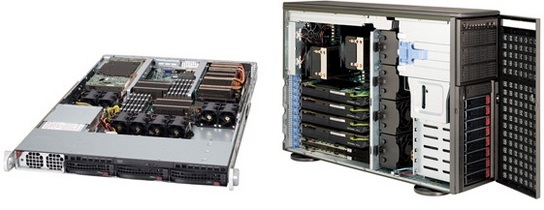Supermicro to expand their GPU servers to include Fermi-level Tesla
by Ian Cutress on May 4, 2010 11:31 AM EST- Posted in
- IT Computing
Supermicro have launched today their second generation of GPU computing servers, using NVIDIA Tesla 20-series GPUs. This product line is an upgrade from their first generation servers, and features a 1U server with 2x M2050 Tesla cards; a 4U tower that supports four C2050 Tesla GPUs, three other PCI-E cards, and support for eight hot-swappable 3.5" SAS/SATA drives; and a 2U twin server that supports two hot-pluggable GPU nodes and onboard QDR InfiniBand for 40GB/sec connectivity.

The NVIDIA Tesla M2050 is a workstation level version of the GTX470 with 448 CUDA cores, but with 3GB GDDR5 ECC memory and a passive heatsink. The C2050 is an M2050 with an increased memory bandwidth (144GB/sec to 148GB/sec) due to faster memory, and is actively cooled.
All Supermicro systems are compatible with dual Intel Xeon 5500/5600 processors (up to 16 threads) and 192GB Registered ECC DDR3-1333Mhz RAM. Both the 1U server and 4U tower are supplied with a redundant 1400W Gold level (93%) high efficiency power supply. Makes you wonder though for the 4U unit - four Fermi cards, two Nehalem Xeons, is 1400W enough?
NVIDIA Tesla cards and their computing languages have been welcome technologies in various computational scientific fields over these past few years - medical imaging, oil and gas exploration, quantum chemistry, financial simulation, astrophysics, folding and various BOINC projects to name but a few. A few companies have started to offer GPU integration into their server systems, and Supermicro has always been on my list of companies to watch out for with regards Tesla workstations in my day-to-day job (computational chemistry).
In terms of pricing, think a few thousand dollars per Tesla GPU, $1000 for two Xeon 5520s and cooling, $2000 for the power supply, 4U tower, and general cooling, $1000 for the motherboard, and $500-$20000 for how much RAM you would like. Coming soon to a Supermicro approved reseller near you (if you can afford it)!










23 Comments
View All Comments
Souka - Tuesday, May 4, 2010 - link
I just have to ask....what would the Fps be in Crysis? :)jonup - Tuesday, May 4, 2010 - link
FOTCLjagoop - Tuesday, May 4, 2010 - link
Never min Crysis - Minesweeper would totally rock on this box!taltamir - Tuesday, May 4, 2010 - link
you would think so, but you would be wrong.I have one and I have to tell you minesweeper lags, and it doesn't even have a cup holder!
jagoop - Tuesday, May 4, 2010 - link
Never mind Crysis - Minesweeper would totally rock on this box!Rajinder Gill - Tuesday, May 4, 2010 - link
LOL, you folks are killing me..TonyB - Tuesday, May 4, 2010 - link
FU!!! My brother died trying to run Crysismfago - Tuesday, May 4, 2010 - link
The chassis [PSU, MB, case] is actually about $1500 total, but are very hard to find to purchase separately.A decent system with 2x C2050, 2x E5620, and 12 GB DDR3 is about $9k from a reseller (e.g., Silicon Mechanics). $5k of that is for the Tesla cards... Note the Tesla are only 225 W, so the 1400 W PSU should be ok with four GPUs and two good CPUs (4x 225 W + 2x 130 W), as long as there are not many other high-power components.
HOWEVER, I've been reading on the NVIDIA CUDA developer forums that there are all kinds of issues with systems such as these as they have two chipsets (one connected to each CPU) to provide the 4x PCIe 16x slots required.
Has anyone actually used one of these?!
Thanks,
Matt
IanCutress - Tuesday, May 4, 2010 - link
The Tesla C2050/2070s are rated at 247W, so 4 of those and 2 130W Xeons is approximately 1260W, but then add in all the RAM (up to 196GB), any extra PCI-E cards and hot swappable drives, and you're near the limit (depending whether the 1400W is the 93% value, or the actual value is 1400 * 0.93 = 1302W), but more than likely the PSU has some head room.I currently run a dual Xeon 5520 system with a basic CUDA card without trouble, but that system was purchased from Dell, and we didn't think about CUDA development when we bought it, hence the possibility of getting one of these. However, I still have severe issues regarding heat dissipation if I'm going to run them at load essentially 24/7.
All the best,
Ian
mfago - Tuesday, May 4, 2010 - link
Actually, the PSU is only 1100 W on 120 v. To get 1400 W you need 240 V AC. So, quite limited.Another thing that worries me about that system is the six 5000 RPM fans. This thing is obviously meant for a server room, not an office!
- Matt